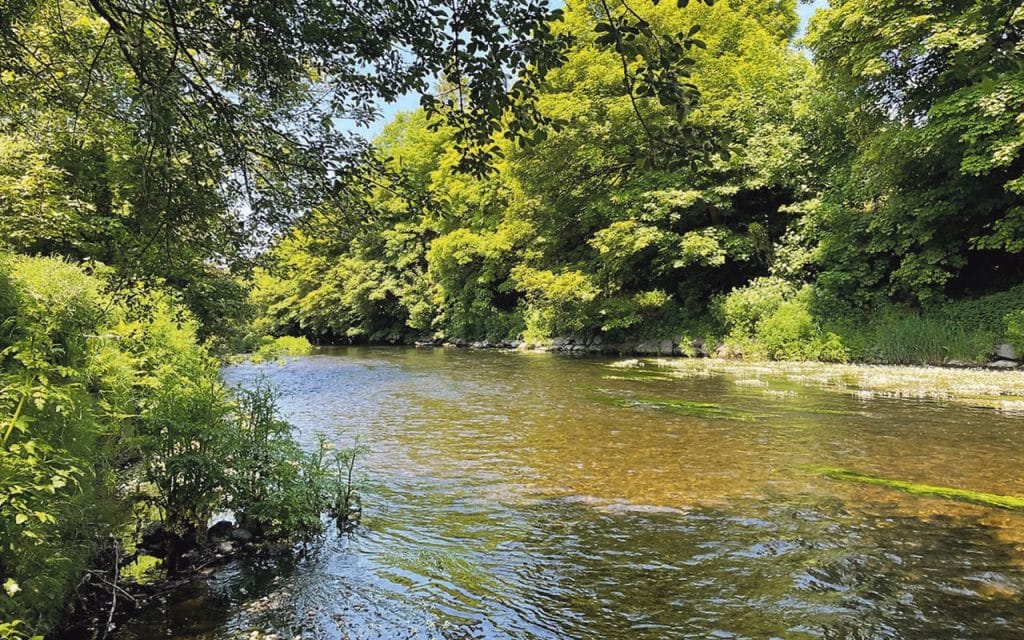Ian Wild, part of the Save Murragh Action Group, committed to protecting the Bandon River Valley, takes us on a walk alongside the Bandon River and reminds us of the bigger picture.

I usually step out each morning for a walk by the Bandon River, just across from where a gravel pit has been proposed. It’s a beautiful part of the world, any time of the year. In fact, winter is often the best time to see a leaping salmon or foraging otter. I find the walk meditative and soothing. The river, never different, is always changing. There’s always something rewarding to see, hear or smell. Fresh coconut odour of the gorse, a kingfisher’s arrow-like flight, the chatter of starlings mustering in trees. How much is all this worth, I sometimes wonder? A couple of hundred euros? A thousand? A million? Otters and pearl mussels, however, do not have a price tag. You can wipe them out and not be presented with a bill. To the hard-nosed realists who say we need sand and gravel to feed the construction industry and provide much needed housing, the above-mentioned creatures are, in Euros, worth nothing. Not a single cent. Nor is there a price on my meditations, nor my encounters with the natural world. Having a beautiful piece of countryside to walk in as a balm for the soul never reaches the costings on a spreadsheet.
“We need houses, thus we need gravel”; that is what the hard-nosed realists say. “You can’t build houses without concrete. And there’s a housing shortage. Talk of biodiversity and protecting the natural world is just airy-fairy dreaming when these ‘difficult’ decisions have to be made. We must be ‘pragmatic’. A few acres, breeding sites, waterways destroyed to make cement for houses is just realism. A tough decision to be made by the stony-snouted. Unfortunately, the otters, pearl mussels, salmon, butterflies, bees, whooper swans and so forth will have to go. For the construction industry must be fed, houses built and jobs created. To claim anything else is not to live in the real world.”
I’m sure those chopping down the Amazonian rain forest to clear land for cattle farming would argue the same. But if we don’t put a price on these things and cost them into exploitation of natural resources, we will pay for them in other ways. Peter is being robbed to pay Paul.
For in the bigger picture that the ‘pragmatic’ don’t wish to acknowledge, heads somewhat appropriately in the sand, cement and concrete is responsible for nine per cent of the world’s carbon emissions. It’s the biggest single cause of emissions. If cement were a nation, only the US and China would have greater C02 emissions. It has the carbon footprint of a yeti. And as Ireland is on course to deliver only a 29 per cent reduction of emissions by 2030 – well below the 51 per cent target in the Government’s Climate Action Plan, it faces fines from the EU of anything between €3bn and €8bn. Which makes using more cement ‘not’ realistic. It’s hard-nosed bad accountancy. Only the Irish taxpayer and not the polluter will pick up the bill.
But do we need to use so much concrete? As far as houses are concerned, there are much cheaper, quicker and more ecologically sound methods to build dwellings. There is wood for example.
“Ah, sure but that won’t last. This is Ireland. The rain will rot a wooden house in a couple of years.”
Not so. Both timber and block houses have a design life of 60 years in Ireland. Over 85 per cent of new houses in Scotland are timber-framed, and the climate there is no less soggy. In fact, timber frame construction is the most popular building method in the world, accounting for 90 per cent of North American and Scandinavian housing for example – places where there can also be extremes of weather. Thousands of wooden-framed houses survive in the UK from Tudor times. And in the middle of a housing crisis, this can be said of timber houses: they are cheaper, much quicker to build and carbon-neutral because the wood itself stores carbon. A wooden home, if produced from sustainable timber has the carbon footprint of a mouse. You would wonder why the hard-nosed realists aren’t out there with their hammers and nails.
With only a touch more imagination and daring, one might suggest an adobe or cob house. One billion people across the world live in adobe houses, many in the tropics. There are cob houses 500-years-old in England. In Ireland, just north of Enniskeane, The Hollies provides beautiful and sustainable examples of modern housing that doesn’t use any concrete at all. The Kinsale College Amphitheatre was built from cob and timber and the cob walls are still sound, and cost – ‘nothing’.
So, it is not true that the only pragmatic way forward is to use ever more concrete and open ever more gravel pits at grievous environmental cost. Those in charge of large businesses who wish to profit from exploitation of the environment would like us to believe their myths. But we will all be impoverished if they get their way. It is as if the worsening, destructive storms of recent years are howling at us: listen to the soft-nosed realists.


